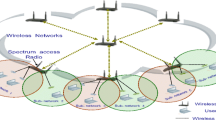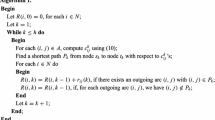Abstract
This paper introduces an information-theoretic upper bound on the capacity scaling law for a hierarchical hybrid network (HierHybNET), consisting of both n wireless ad hoc nodes and m base stations (BSs) equipped with l multiple antennas per BS, where the communication takes place from wireless nodes to a remote central processor through BSs in a hierarchical way. We deal with a general scenario where m, l, and the backhaul link rate scale at arbitrary rates relative to n. Then, a generalized cut-set upper bound under the HierHybNET model is derived by cutting not only the wireless connections but also the wired connections. In addition, the corresponding infrastructure-limited regime is identified.










Similar content being viewed by others
Notes
We use the following notation: (1) \(f(x)=O(g(x))\) means that there exist constants C and c such that \(f(x)\le Cg(x)\) for all \(x>c\), (2) \(f(x)=o(g(x))\) means that \(\lim _{x\rightarrow \infty }\frac{f(x)}{g(x)}=0\), (3) \(f(x)=\Omega (g(x))\) if \(g(x)=O(f(x))\), (4) \(f(x)=w(g(x))\) if \(g(x)=o(f(x))\), and (5) \(f(x)=\varTheta (g(x))\) if \(f(x)=O(g(x))\) and \(g(x)=O(f(x))\) [22].
To simplify notations, \(T_n(\alpha ,\beta ,\gamma ,\eta )\) will be written as \(T_n\) if dropping \(\alpha\), \(\beta\), \(\gamma\), and \(\eta\) does not cause any confusion.
Here and in the sequel, the noise variance is assumed to be one to simplify the notation.
To simplify notations, the terms including \(\epsilon\) are omitted if dropping them does not cause any confusion.
References
Gupta, P., & Kumar, P. R. (2000). The capacity of wireless networks. IEEE Transactions on Information Theory, 46, 388–404.
Shin, W.-Y., Jeon, S.-W., Devroye, N., Vu, M. H., Chung, S.-Y., Lee, Y. H., et al. (2008). Improved capacity scaling in wireless networks with infrastructure. IEEE Transactions on Information Theory, 57, 5088–5102.
Özgür, A., Lévêque, O., & Tse, D. N. C. (2007). Hierarchical cooperation achieves optimal capacity scaling in ad hoc networks. IEEE Transactions on Information Theory, 53, 3549–3572.
Cover, T. M., & Thomas, J. A. (1991). Element of information theory. New York: Wiley.
Meng, T., Wu, F., Yang, Z., Chen, G., & Vasilakos, A. V. (2015). Spatial reusability-aware routing in multi-hop wireless networks. IEEE Transactions on Computers, to appear.
Li, P., Guo, S., Yu, S., & Vasilakos, A. V. (2012). CodePipe: An opportunistic feeding and routing protocol for reliable multicast with pipelined network coding. In Proceedings of IEEE INFOCOM, pp. 100–108.
Li, P., Guo, S., Yu, S., & Vasilakos, A. V. (2014). Reliable multicast with pipelined network coding using opportunistic feeding and routing. IEEE Transactions on Parallel and Distributed Systems, 25, 3264–3273.
Zhang, X. M., Zhang, Y., Yan, F., & Vasilakos, A. V. (2015). Interference-based topology control algorithm for delay-constrained mobile ad hoc networks. IEEE Transactions on Mobile Computing, 14, 742–754.
Liu, J., Wan, J., Wang, Q., Deng, P., Zhou, K., & Qiao, Y. (2015). A survey on position-based routing for vehicular ad hoc networks. Telecommunication Systems, 59, 1–16.
Liu, J., Wan, J., Wang, Q., Li, D., Qiao, Y., & Cai, H. (2015). A novel energy-saving one-sided synchronous two-way ranging algorithm for vehicular positioning. Mobile Networks and Applications, 20, 1–12.
Jiang, T., Wang, H., & Vasilakos, A. V. (2012). QoE-driven channel allocation schemes for multimedia transmission of priority-based secondary users over cognitive radio networks. IEEE Journal on Selected Areas in Communications, 30, 1215–1224.
Attar, A., Tang, H., Vasilakos, A. V., Yu, F. R., & Leung, V. C. M. (2012). A survey of security challenges in cognitive radio networks: Solutions and future research directions. Proceedings of the IEEE, 100, 3172–3186.
Quan, W., Xu, C., Vasilakos, A. V., Guan, J., Zhang, H., & Grieco, L. A. (2014). TB2F: Tree-bitmap and bloom-filter for a scalable and efficient name lookup in content-centric networking. In Proceedings of IFIP networking conference, pp. 1–9.
Vasilakos, A. V., Li, Z., Simon, G., & You, W. (2015). Information centric network: Research challenges and opportunities. Journal of Network and Computer Applications, 52, 1–10.
Lopez-Perez, D., Chu, X., Vasilakos, A. V., & Claussen, H. (2013). On distributed and coordinated resource allocation for interference mitigation in self-organizing LTE networks. IEEE/ACM Transactions on Networking, 21, 1145–1158.
Lopez-Perez, D., Chu, X., Vasilakos, A. V., & Claussen, H. (2014). Power minimization based resource allocation for interference mitigation in OFDMA femtocell networks. IEEE Journal on Selected Areas in Communications, 32, 333–344.
Khan, M. A., Tembine, H., & Vasilakos, A. V. (2012). Game dynamics and cost of learning in heterogeneous 4G networks. IEEE Journal on Selected Areas in Communications, 30, 198–213.
Duarte, P. B. F., Fadlullah, Z. M., Vasilakos, A. V., & Kato, N. (2012). On the partially overlapped channel assignment on wireless mesh network backbone: A game theoretic approach. IEEE Journal on Selected Areas in Communications, 30, 119–127.
Vasilakos, A. V., Ricudis, C. Anagnostakis, K. G., Pedrycz, W., Pitsillides, A., & Gao, X. Z. (1998). Evolutionary-fuzzy prediction for strategic ID-QoS routing in broadband networks. In Proceedings of IEEE international conference on Fuzzy, pp. 1488–1493.
Yang, M., Li, Y., Jin, D., Zeng, L., Wu, X., & Vasilakos, A. V. (2015). Software-defined and virtualized future mobile and wireless networks: A survey. Mobile Networks and Applications, 20, 4–18.
Demestichas, P. P., Stavroulaki, V.-A. G., Papadopoulou, L.-M. I., Vasilakos, A. V., & Theologou, M. E. (2004). Service configuration and traffic distribution in composite radio environments. IEEE Transactions on Systems, Man, and Cybernetics-Part C: Applications and Reviews, 34, 69–81.
Knuth, D. E. (1976). Big omicron and big omega and big theta. ACM Special Interest Group on Algorithms and Computation Theory (SIGACT) News, 8, 18–24.
Franceschetti, M., Dousse, O., Tse, D. N. C., & Thiran, P. (2007). Closing the gap in the capacity of wireless networks via percolation theory. IEEE Transactions on Information Theory, 53, 1009–1018.
Shin, W.-Y., Chung, S.-Y., & Lee, Y. H. (2013). Parallel opportunistic routing in wireless networks. IEEE Transactions on Information Theory, 59, 6290–6300.
El Gamal, A., Mammen, J., Prabhakar, B., & Shah, D. (2006). Optimal throughput-delay scaling in wireless networks-Part I: The fluid model. IEEE Transactions on Information Theory, 52, 2568–2592.
Niesen, U., Gupta, P., & Shah, D. (2010). The balanced unicast and multicast capacity regions of large wireless networks. IEEE Transactions on Information Theory, 56, 2249–2271.
Grossglauser, M., & Tse, D. N. C. (2002). Mobility increases the capacity of ad hoc wireless networks. IEEE/ACM Transactions on Networking, 10, 477–486.
Cadambe, V. R., & Jafar, S. A. (2008). Interference alignment and degrees of freedom of the \(K\)-user interference channel. IEEE Transactions on Information Theory, 54, 3425–3441.
Niesen, U. (2011). Interference alignment in dense wireless networks. IEEE Transactions on Information Theory, 57, 2889–2901.
Yi, S., Pei, Y., Kalyanaraman, S., & Azimi-Sadjadi, B. (2007). How is the capacity of ad hoc networks improved with directional antennas? Wireless Networks, 13, 635–648.
Li, P., Zhang, C., & Fang, Y. (2011). The capacity of wireless ad hoc networks using directional antennas. IEEE Transactions on Mobile Computing, 10, 1374–1387.
Yoon, J., Shin, W.-Y., & Jeon, S.-W. (2014). Elastic routing in wireless networks with directional antennas. In Proceedings of IEEE international symposium of information theory (ISIT), pp. 1001–1005.
Zemlianov, A., & de Veciana, G. (2005). Capacity of ad hoc wireless networks with infrastructure support. IEEE Journal of Selected Areas on Communications, 23, 657–667.
Dousse, O., Thiran, P., & Hasler, M. (2002). Connectivity in ad-hoc and hybrid networks. In Proceedings of IEEE INFOCOM, pp. 1079–1088.
Liu, B., Thiran, P., & Towsley, D. (2007). Capacity of a wireless ad hoc network with infrastructure. In Proceedings of ACM international symposium on mobile ad hoc networking and computing (MobiHoc), pp. 239–246.
Kozat, U. C., & Tassiulas, L. (2003). Throughput capacity of random ad hoc networks with infrastructure support. In Proceedings of ACM international conference on mobile computing and networking (MobiCom), pp. 55–65.
Çapar, Ç., Goeckel, D., Towsley, D., Gibbens, R., & Swami, A. (2011). Cut results for the capacity of hybrid networks. In Proceedings of annual confererence of international technology alliance (ACITA), pp. 1–2.
Çapar, Ç., Goeckel, D., Towsley, D., Gibbens, R., & Swami, A. Capacity of hybrid networks. In Proceedings of annual conference of international technology alliance (ACITA), pp. 1–8.
Jeong, C., & Shin, W.-Y. (2013). Large-scale ad hoc networks with rate-limited infrastructure: Information-theoretic operating regimes. In Proceedings of IEEE international symposium on information theory (ISIT), pp. 424–428.
Marsch, P., & Fettweis, G. (2007). A framework for optimizing the uplink performance of distributed antenna systems under a constrained backhaul. In Proceedings of IEEE international conference on communications (ICC), pp. 975–979.
Nazer, B., Sanderovich, A., Gastpar, M., & Shamai (Shitz), S. (2009). Structured superposition for backhaul constrained cellular uplink. In Proceedings of IEEE international symposium on information theory (ISIT), pp. 1530–1534.
Sanderovich, A., Somekh, O., & Shamai (Shitz), S. (2007). Uplink macro diversity with limited backhaul capacity. In Proceedings of international symposium on information theory (ISIT), pp. 11–15.
Shamai (Shitz), S., Simeone, O., Somekh, O., & Sanderovich, A. (2009). Uplink macro diversity of limited backhaul cellular network. IEEE Transactions on Information Theory, 55, 3457–3478.
Shamai (Shitz), S., Simeone, O., Somekh, O., & Sanderovich, A. (2008). Information-theoretic implications of constrained cooperation in simple cellular models. In Proceedings of IEEE annual international symposium on personal, indoor, and mobile radio communications (PIMRC), pp. 1–5.
Gomez-Cuba, F., Rangan, S., & Erkip, E. (2014). Scaling laws for infrastructure single and multihop wireless networks in wideband regimes. In Proceedings of IEEE international symposium on information theory (ISIT), pp. 76–80.
Viswanath, P., & Tse, D. N. C. (2003). Sum capacity of the vector Gaussian broadcast channel and uplink-downlk duality. IEEE Transactions on Information Theory, 49, 1912–1921.
Constantinescu, F., & Scharf, G. (1998). Generalized Gram-Hadamard inequality. Journal of Inequalities and Applications, 2, 381–386.
Jovicic, A., Viswanath, P., & Kulkarni, S. R. (2004). Upper bounds to transport capacity of wireless networks. IEEE Transactions on Information Theory, 50, 2555–2565.
Acknowledgments
This research was supported by the Basic Science Research Program through the National Research Foundation of Korea (NRF) funded by the Ministry of Education (2014R1A1A2054577) and by the research fund of Dankook University(BK21 Plus) in 2014. This paper was presented in part at the 2014 IEEE International Symposium on Information Theory, Honolulu, HI, June/July 2014.
Author information
Authors and Affiliations
Corresponding author
Rights and permissions
About this article
Cite this article
Jeong, C., Shin, WY. HierHybNET: Cut-set upper bound of ad hoc networks with cost-effective infrastructure. Wireless Netw 22, 1133–1144 (2016). https://doi.org/10.1007/s11276-015-1017-x
Published:
Issue Date:
DOI: https://doi.org/10.1007/s11276-015-1017-x




